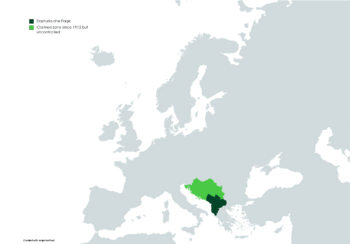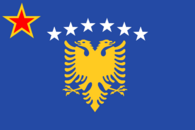Dashuria dhe Paqe
Republic of Dashuria dhe Paqe Republika e Dashuria dhe Paqe (Albanian) Republika Dashuria dhe Paqe (Croatian) Republika Dašurija i Paḱe (Macedonian) Republika Dašurija i Paće (Serbian) Republika Dashuria i Paqe (Bosnian) | |
|---|---|
Motto: Ti Dashuria, më jep nder, më jep emrin Dashuriëtar (Albanian) "You Dashuria, give me honour, you give me the name Dashurian" | |
 Map of Dashuria dhe Paqe with claimed zones | |
| Capital | Hoxha |
| Official languages | Albanian |
| Languages in official use | |
| Vehicular language (or interethnic) | Russian |
| Ethnic groups (2090) | 87.75% Albanians 0.50% Greeks 0.30% Macedonians 0.25% Montenegrins 0.10% Romani |
| Religion (2090) | 24.8% Atheist or Agnostics 24.65% Islam 22.87% Christians |
| Demonym(s) | Dashuri or Dashurian |
| Government | Federal Marxist-Leninist one-party socialist republic under a totalitarian hoxhaist dictatorship |
• People's Commissar | Enver Hoxha |
• Speaker of the People's Congress of the Nations | Rustem Jakova |
| Legislature | People's Congress of the Nations |
| Independence from Albania and Serbia | |
| Area | |
• Total | 53,447 km2 (20,636 sq mi) |
| Population | |
• Estimate | 8568532 |
• Density | 160/km2 (414.4/sq mi) |
| Gini | 47 high |
| HDI | 0.371 low |
| Currency | Dashurian Lek (DLK) |
| Time zone | UTC+1 (CET) |
• Summer (DST) | UTC+2 (CEST) |
| Driving side | right |
| |
Dashuria dhe Paqe officially Republic of Dashuria dhe Paqe , is a country in East Europe, formed by many ex-Yugoslavian countries. It is border on the north and the east by Serbia, on the west by Bosnia and Herzegovina and the Adriatic Sea, on the south by Greece and on the east by Bulgaria. It comprises 121 provinces and its capital and economic centre is Hoxha. Dashuria dhe Paqe is Albanian for Love and Peace, and intends to be a country free of all wars and sufferings. However, by many countries, it is still considered an authoritarian totalitarian state.
History
Many of you have heard about the Balkan War. The faction formerly known as the Balkan league wanted to come back to socialist times. Albanians, Kosovars, Serbians, Montenegrin and Macedonians gained independence from their respective countries and led by Enver Hoxha's great-great grandson (also named Enver) started a new socialist revolution emending the past errors and creating a more human vision of socialism. The media is no more state-controlled and religion is no way prosecuted.
Government and politics
Dashuria is governed under a Federal Republic. The People's Commissariat (Executive) is formed by seven members of the different ethnic groups of the country and it's represented abroad by the People's Commissar (informally called Prime Minister). Legislature, unicameral, is the responsible of voting the laws proposed by the government and ammend the Constitution. In case of infraction, in certain circumstances, it can present a vote of no comfidence against a member of the Cabinet. Since 1941, the country is governed solely by the Coalition of Labour and Peace for Dashuria, with the Party of Labour being the most represented. Other minor parties represent ethnic minorities like the Serbians or the Roma. Constitutionally, at least 5% of the seats are reserved to people with disabilities, women and qualified students. Religious parties are outlawed due to be a sensitive topic. The Judiciary is represented by the People's Supreme Council of Justice, with thirteen members elected by the Prime Minister with the consent of three thirds of the Assembly. Their main duty is to preserve the rule of law and to observe judges' daily behaviour.
Elections take place every four years for the executive and five for municipalities.
Administrative divisions
Dashuria is a Federal state that comprises 121 provinces, each one subdivided in municipalities. The municipalities are governed by mayors elected by the people in the local elections, celebrated every five years.
Geography
Dashuri has an area of 53447 km2 and it's located in the Balkan Peninsula in South East Europe. The highest point is Korab, with 2764 m above the Adriatic.
Climate
Due to its amount of raifall, most of Dashuria doesn't fall in Mediterranean climate. According to Köppen climate classification, the south, central and west of the country has a humid subtropical climate, characterized by mild dry winters and warm or hot humid summers. Temperature averages vary from 24.2 °C (75.6 °F) in summer to 6.4 °C (43.5 °F) in winter. Rainfall is most common during spring and summer, with frequent but relatively short lightning storms.
| Month | Jan | Feb | Mar | Apr | May | Jun | Jul | Aug | Sep | Oct | Nov | Dec | Year |
|---|---|---|---|---|---|---|---|---|---|---|---|---|---|
| Average high °C (°F) | 10.5 (50.9) |
11.8 (53.2) |
16.7 (62.1) |
20.1 (68.2) |
24.9 (76.8) |
28.8 (83.8) |
31.8 (89.2) |
31.8 (89.2) |
28.4 (83.1) |
20.7 (69.3) |
16.0 (60.8) |
11.9 (53.4) |
21.1 (70.0) |
| Daily mean °C (°F) | 5.6 (42.1) |
6.6 (43.9) |
11.1 (52.0) |
14.5 (58.1) |
19.0 (66.2) |
22.7 (72.9) |
25.0 (77.0) |
24.9 (76.8) |
21.8 (71.2) |
14.8 (58.6) |
10.6 (51.1) |
7.0 (44.6) |
15.3 (59.5) |
| Average low °C (°F) | 0.7 (33.3) |
1.5 (34.7) |
5.6 (42.1) |
9.0 (48.2) |
13.2 (55.8) |
16.7 (62.1) |
18.3 (64.9) |
18.0 (64.4) |
15.2 (59.4) |
9.0 (48.2) |
5.2 (41.4) |
2.1 (35.8) |
9.5 (49.2) |
| Average rainfall mm (inches) | 53 (2.1) |
41 (1.6) |
135 (5.3) |
144 (5.7) |
150 (5.9) |
158 (6.2) |
172 (6.8) |
136 (5.4) |
108 (4.3) |
103 (4.1) |
92 (3.6) |
58 (2.3) |
1,350 (53.3) |
| Average precipitation days | 4.8 | 7.2 | 8.3 | 10.9 | 11.7 | 11.9 | 13.4 | 12.5 | 10.3 | 7.5 | 6.4 | 4.8 | 109.7 |
| Average relative humidity (%) | 57 | 64 | 70 | 73 | 81 | 85 | 87 | 79 | 71 | 69 | 62 | 60 | 72 |
Biodiversity
Located in Southeastern Europe, Dashuria receives floral and faunal species from Europe and Eurasia. Forests are widespread in Dashuria and cover at least 39% of the region. Phytogeographically, it straddles the Illyrian province of the Circumboreal Region within the Boreal Kingdom. In addition, it falls within three terrestrial ecoregions: Balkan mixed forests, Dinaric Mountains mixed forests, and Pindus Mountains mixed forests. Dashuria's biodiversity is conserved in two national parks, eleven nature reserves and one hundred three other protected areas. The Bjeshkët e Nemuna National Park and Sharr Mountains National Park are the most important regions of vegetation and biodiversity in Dashuria. Dashuria had a 2089 Forest Landscape Integrity Index mean score of 5.19/10, ranking it 107th globally out of 172 countries.
Flora encompasses more than 1,800 species of vascular plant species, but the actual number is estimated to be higher than 2,500 species. The diversity is the result of the complex interaction of geology and hydrology creating a wide variety of habitat conditions for flora growth. Although, Dashuria represents only 10% of the entire surface area of the Balkans, in terms of vegetation it has 25% of the Balkan flora and about 18% of the European flora. The fauna is composed of a wide range of species. The mountainous west and southeast provide a great habitat for several rare or endangered species including brown bears, lynxes, wild cats, wolves, foxes, wild goats, roebucks and deers. A total of 255 species of birds have been recorded, with raptors such as the golden eagle, eastern imperial eagle and lesser kestrel living principally in the mountains of Dashuria.
Topography
The most significant feature in Dashuria is possibly its relief, with numerous successive mountain ranges and its average altitude, more than 700 metres above sea level. Much of the mountains lie to the north, west and south of the western lowlands in the northern, western and southern mountain ranges.
The Dashurian Alps extend over 90 kilometres through the north of the country, traversing an area of 2,000 square kilometres. These mountains represent an extension of the Dinaric Alps and no wider than 40 kilometres. They are deeply fragmented and often inaccessible. It holds the Maja Jezercë, which is the highest point of the Dinarides and simultaneously the second highest point of Dashuria.
The Korab Mountains dominate the east of the country and expand 40 kilometres along the eastern border of the country, where peaks can clearly reach 2,500 metres. The mountains offer the country's most prominent peak at Mount Korab, which is fragmented by many deep structural depressions. Another distinguishing feature remains the evidence of the last ice age in form of glacial lakes at relatively low altitudes.
One of the most remarkable features about the west of Dashuria is the presence of the Ceraunian Mountains that cut across the landscape for nearly 100 kilometres. Thousand meter high mountains fall vertically into the Mediterranean Sea constituting at least the first barrier to communication between the sea and the country's southern inland.
Economy
From 1972, Dashuria runs its economy by the state-capitalist model. The government is the responsible to plan the economic matters with five-years plans. Since the Dashurian-Asian split, there is a major opening to private entepreneurs. The government encourages the private property to have an important role in the economy. However, economic worldwide institutions classify Dashurian economy as Imploded. In the coast, the trout-fishing industry plays an important role and employs many million of people. In the highest urban areas, Information Technology industry and Uranium Mining are the most important contributions to the economy. In 1990s when the country abandoned the centralized state-run economy, the unemployment rate lowered considerably. Nowadays, unemployment rate is around 20-25% in the urban areas and almost non-existent in the rural areas.
Income
Dashuria is a low-income country, with 6796 Dashurian lek (USD 60) per capita according to state-run sources.
Primary Sector
Around 3.5% of the population works in the agricultural sector. Around 4,350,000 hectares (10,700,000 acres) of hectares are cultivated every year, with maize and olives being the most planted greens. In most of the country, the farmers tend to implement organic methods of agriculture, with less or no use of agrochemicals in most cases. In the coastal areas, fisherpeople are mostly sean through the Adriatic Sea. Most common fishes are Arbun, Brancin, Grdobina, Kantar, Kovač, Lokarda, Murina, Orada, Oslić and Pic. In some zones of the east, grape-based agriculture and good climate gives path to wineyards.
